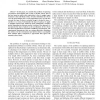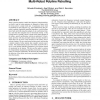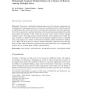31 search results - page 5 / 7 » Extreme work teams: using SWAT teams as a model for coordina... |
ICRA
2008
IEEE
14 years 1 months ago
2008
IEEE
— As part of a program to find methods of reducing spatial interference in multi-robot systems, we propose the Interaction Grid (IG), a generalization of the Occupancy Grid that...
ICRA
2006
IEEE
14 years 1 months ago
2006
IEEE
— In this paper, we consider the problem of exploring an unknown environment with a team of mobile robots. One of the key issues in multi-robot exploration is how to assign targe...
ATAL
2008
Springer
13 years 9 months ago
2008
Springer
There is growing interest in multi-robot frequency-based patrolling, in which a team of robots optimizes its frequency of point visits, for every point in a target work area. In p...
ATAL
2005
Springer
14 years 1 months ago
2005
Springer
Just as POMDPs have been used to reason explicitly about uncertainty in single-agent systems, there has been recent interest in using multi-agent POMDPs to coordinate teams of age...
SWARM
2008
SPRINGER
13 years 7 months ago
2008
SPRINGER
We present a biologically inspired approach to the dynamic assignment and reassignment of a homogeneous swarm of robots to multiple locations, which is relevant to applications lik...



